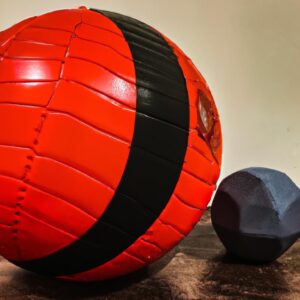Get Strong for Real Life: Try Functional Fitness Today!

Introduction to Functional Fitness: What is It and Why Should You Do It?
Functional fitness is a type of physical training that focuses on building strength and mobility for activities regularly performed in everyday life. The principle behind functional fitness is that the exercises you do should improve how well your body can move when performing everyday activities, such as lifting, carrying, climbing stairs, or even playing sports. In short, functional fitness helps you become strong enough to manage your daily life with ease.
The exercises involved in functional fitness range from simple bodyweight exercises to more complex movements, such as Olympic lifts and plyometrics. The beauty of functional fitness is that it can be tailored to fit any skill level, from beginner to advanced. It is also suitable for all ages and body types, making it a great way to stay active and healthy.
The main benefits of functional fitness are improved strength, flexibility, balance, and coordination. By focusing on movements performed in regular life, functional fitness provides a great foundation for many sports and activities. It improves muscle strength, stability, and overall cardiovascular health. Additionally, it can help reduce the risk of injury, reduce fatigue, and improve posture.
In other words, functional fitness is a fantastic way to stay fit and healthy, which is why we highly recommend it. So, if you want to make your everyday life easier, build strength, and improve your overall fitness, functional fitness can help you achieve just that.
Types of Functional Fitness Exercises
Functional fitness is an exercise style that focuses on simulating movements used in everyday life. It uses exercises that are designed to increase strength and flexibility while improving balance and stability. These exercises are intended to help individuals develop the strength needed for everyday activities, such as lifting items, going up and down stairs, reaching, bending, and more.
Functional fitness exercises can be divided into two main categories: bodyweight exercises and weighted exercises. Bodyweight exercises involve using your own body weight as resistance. Examples include push-ups, squats, burpees, pull-ups, planks, and lunges. Weighted exercises involve adding extra resistance by using weights such as dumbbells, kettlebells, sandbags, or medicine balls. An example of a weighted exercise is a biceps curl with a pair of dumbbells.
Functional fitness exercises can also be divided into dynamic movements and static movements. Dynamic movements involve movement of the body through space. Examples include walking lunges, jumping jacks, and mountain climbers. Static exercises require an individual to hold a certain position or pose for several seconds or longer. Examples include wall sits, bridge holds, and plank holds.
No matter what types of functional fitness exercises you do, it’s important to remember to engage your core muscles and maintain proper form. When done correctly, functional fitness exercises can lead to increased strength and improved performance for everyday activities.
The Benefits of Functional Fitness
Functional fitness exercises provide the perfect combination of strength, balance, and flexibility—all of which are necessary for everyday activities like carrying groceries or playing with your kids. Being functionally fit means having the strength and balance to accomplish everyday tasks with ease.
Functional fitness exercises not only improve physical fitness, but they can also help prevent injuries. By achieving and maintaining functional fitness, you’ll reduce the chances of getting injured because you will be able to move more freely and naturally. This type of exercise also enhances balance and stability, and it helps to strengthen the muscles that support your bones and joints.
Along with injury prevention, functional fitness exercises also have many other benefits. Increased strength can lead to improved posture and better neuromuscular control, which is especially important for athletes. You’ll also be able to perform daily tasks more easily as functional fitness exercises require multiple joints and muscle groups to work together.
In addition to the physical benefits, functional fitness exercises can also improve mental health. Working out helps to reduce stress and anxiety by releasing endorphins and improving self-esteem. Plus, the exercises can be easily adapted and modified to suit all levels of fitness, so everyone can benefit from them.
Essential Tips for Beginners
Functional fitness is a great way to get strong and stay fit. But if you’re a beginner, it can be intimidating to start. Don’t worry though—there are some easy tips you can use as you begin your functional fitness journey.
- Start slowly. Take breaks between exercises and use proper form. To prevent injuries, never do more than your body can handle.
- Choose exercises that focus on the muscles you want to strengthen. Focus on a few basic exercises at first until you become comfortable with them.
- Reinforce good habits. Be consistent with your workouts, pay attention to form, and keep track of your progress.
- Don’t compare yourself to others. Everyone progresses at their own pace and focusing too hard on comparing yourself to others can be discouraging.
- Set realistic goals. Aim small and achieve big! For example, commit to working out for 10 minutes several times a week instead of trying to workout for an hour every day.
- Always warm-up and cool down. Start slow and ease your way into your workout with some light stretches and dynamic movements. At the end of your workout, spend some time stretching and slowing your heart rate.
By following these tips, you’ll be well on your way to functional fitness success!
Examples of Functional Fitness Exercises
Functional fitness exercises are designed to boost your overall strength and make your daily activities easier. Some of the most effective functional fitness exercises include squats, lunges, pull-ups, push-ups, planks, deadlifts, burpees, and single leg raises.
Squats
Squats are an excellent exercise for strengthening the lower body and core muscles. To do a proper squat, begin in a standing position with feet shoulder-width apart. From here, bend your knees, push your hips back, and keep your chest up. Lower your body until your thighs are parallel to the floor or lower. Then, stand back up and repeat the motion. This exercise can also be done with weights or a barbell held across your shoulders.
Lunges
Lunges target and strengthen several major muscle groups in the legs. To do a proper lunge, start by standing tall and take a large step forward with one foot. Lower your body until both of your knees are bent to 90 degrees. Make sure that your front knee does not go past your toes. Push off your front foot to return to the starting position and switch legs. This exercise can also be done while holding weights in each hand.
Pull-Ups
Pull-ups are a challenging but effective exercise that works the entire upper body, especially the back muscles. To do this exercise, you’ll need a pull-up bar or a place to hang from. Start by gripping the bar with your hands just wider than shoulder width apart. Engage your core and slowly pull your body up until your chin is over the bar. Hold the position for a few seconds before lowering your body back down. Pull-ups can be made more challenging by using additional weight in a weighted vest or dumbbell between the legs.
Push-Ups
Push-ups are a great full-body exercise that works the arms, chest, shoulders, core, and legs. To do a traditional push-up, begin in a plank position. Make sure that your hands are placed directly under the shoulders. Keeping your core tight and your back straight, lower your body until your chest touches the ground and then push back up. This exercise can also be modified by doing them on your knees or by placing your hands on an elevated surface like a bench or box.
Stretches to help Improve Range of Motion
Functional fitness is all about being able to move effectively in everyday life. This means having a wide range of motion, so that you can easily perform tasks that require bending, reaching, and other dynamic movements. Stretching can help improve flexibility, allowing you to better use the full potential of your joints and muscles.
Here are some of the best stretches for improving range of motion:
- Dynamic stretching – These types of stretches involve continuous movement and are great for pre-workout warm-ups. Examples include leg swings, arm circles, and butt kicks.
- Static stretching – Slow, controlled, and sustained stretches held for a certain period of time. Examples include hamstring stretches, quadricep stretches, and shoulder stretches.
- Foam rolling – This is a type of self-massage using a foam roller that helps relieve muscle tightness and improve range of motion.
It’s important to note that the key to getting the most out of these stretches is consistency. Make sure to incorporate stretching into every functional fitness session in order to gradually improve your range of motion and reduce your risk of injury.
Advanced Type Functional Fitness Exercises
When you have achieved a level of comfort with the basic functional fitness exercises, you can start introducing more advanced exercises into your routine. Some examples of advanced functional fitness exercises are:
- Medicine Ball Work: using a medicine ball to push, press and kick; it helps to strengthen the core and improve balance.
- Kettlebell Swings: kettlebell swings helps to build strength in the hips and even the upper body when the arms are up as if doing regular shoulder presses.
- Turkish Get-Ups: This exercise is great for working on the shoulders, core and the mobility of the arms.
- Mountain Climbers: Mountain climbers are a great way to work on cardiovascular endurance and strength at the same time.
- Barbell Squats: Barbell squats target the lower body muscles and help increase joint stability.
Make sure you use proper form when doing these exercises to avoid any injuries or strain on your body.
Injury Prevention and Treatment Tips
When it comes to functional fitness, prevention is the best medicine. Before beginning any exercise regimen, it’s important to take the necessary precautions to protect yourself from injury. Here are a few tips for avoiding injuries and dealing with them should they occur:
- Warm up before every workout. This will help to get your body prepared for exercise and reduce the risk of muscle soreness or strains.
- Proper form and technique is key. If you can’t do a move correctly, it’s best to focus on mastering the basics first and then progress at a comfortable pace.
- Listen to your body – stop exercising if you experience pain or exhaustion. It’s better to rest and heal than push yourself too hard.
- Know your limits and gradually increase the intensity of your workouts. Too much, too soon can lead to serious injuries.
- If an injury does occur, don’t ignore it. Immediately take steps to treat the injury with rest, ice, compression, and elevation (RICE).
- Consult a doctor if the pain persists or if it doesn’t go away within a few days.
Following these tips will help to ensure that your functional fitness journey is safe and successful. Remember to always stay mindful of your body’s limits, and to never push yourself too hard!
Building Confidence and Setting Goals
For most of us, the journey to fitness starts off quite daunting; you might be feeling self-conscious about your current fitness level or be intimidated by the thought of exercising at all. But as soon as you get started, you’ll start to build confidence in yourself and this will have a snowball effect which will eventually carry you forward.
Functional fitness can provide a great way to learn more about your own capabilities and to set achievable goals. You should start off by setting realistic goals for yourself, such as increasing your reps or increasing the weight of your press ups with time. Give yourself some space to grow and learn – don’t expect yourself to be an expert straight away!
Once you feel comfortable with your functional fitness routine, you can begin to focus on improving your performance. There are lots of resources available online which will help you to track your progress and to keep motivated with your journey. For example, you can use a fitness tracker app which will show you how far you’ve come and which exercises you are making the most progress with.
Another great way to stay motivated is to celebrate the small successes along your journey. Whether it’s beating your personal best reps or increasing the weight of a certain exercise, make sure to pause and appreciate your accomplishments. Over time, these small successes will add up and will give you a great sense of confidence and pride in your journey.
Keys to Success in Functional Fitness
Success in functional fitness comes from dedication and hard work. It’s important to have achievable goals and to focus on the right exercises to help you reach them. The following are some tips to help you feel successful and motivated when engaging in functional fitness.
- Start slowly: Take time to learn and understand the exercises before pushing yourself too hard. A good place to start is with foundational exercise such as squats, push-ups, planks, and core strengthening exercises.
- Set goals: Define what success looks like for you and work towards it. Whether it’s increasing your strength, flexibility, or endurance, having something to aim for will help you stay motivated.
- Listen to your body: Rest and listen to your body so you can avoid injury. If a particular exercise does not feel right, then take a break or find an easier modification.
- Have patience: Results don’t happen overnight, so be patient and consistent. Don’t compare yourself to others and celebrate small victories to keep yourself going.
- Mix it up: Adding variety to your routine helps prevent boredom and keeps things fresh. Incorporate different types of exercises and intensity levels to keep your workouts interesting.
Functional Fitness Equipment
When it comes to functional fitness, you may not need a lot of equipment. Many exercises can be done with just bodyweight and/or minimal equipment. That said, certain items can help you get the most out of your functional fitness journey. Here are some pieces of equipment that may be beneficial to your program:
- Resistance Bands: Resistance bands provide an effective way to increase the difficulty of any exercise while also allowing you to target different muscle groups. They are light-weight and easy to transport.
- Kettlebells: Kettlebells are a great tool for functional fitness as they are versatile and easy to use. They work by activating several muscle groups at once, making them an efficient way to work out.
- Balance Trainers: Balance trainers like Bosu balls or balance boards challenge your coordination and stability, helping to improve your overall balance and performance during functional fitness exercises.
- Ankle Weights: Ankle weights are a cost effective and easy to use piece of equipment for adding resistance. They are also light-weight and portable.
While these are the most common pieces of functional fitness equipment, there are many more products available. Be sure to do your research and find the best option for your goals.
Conclusion: Recap of the Functional Fitness Journey
After reading about functional fitness and its many exercises, you now have a better understanding of what it is and how it can improve your real-life strength and abilities. You know the different types of exercises, the equipment needed for each, and the benefits that come with it. You also understand how to stay safe and injury-free while exercising, and how to set achievable goals for yourself.
Functional fitness is a great way to increase your strength and agility, as well as gain more self-confidence. With the right mindset and dedication, you can achieve amazing results and be on your way to real-life strength. So don’t wait any longer, and start your functional fitness journey today!
comments: 0






